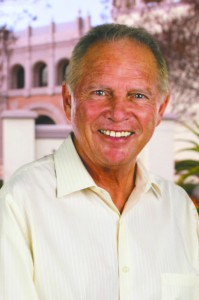Richard Thome is the first to admit it, his iPhone is always on and it is repeatedly checked. Richard loves all kinds of gadgets and is fascinated by electronics. It actually makes perfect sense, since technology has been part of his life and his job for over 40 years.
“My iPhone is my constant companion,” says Thome as he laughs during a one on one interview with La Prensa San Diego. “ It’s always on. When I feel that it’s lost or misplaced, it’s like a piece of me is missing.”
Thome is one of the lucky few who gets to do what he loves for a living. He works as the Director of Professional Learning for the Mobile Technology Learning Center at the University of San Diego, which means he’s always surrounded by technology, data and education. Richard’s job is about much more than just flashy gadgets with extra bells and whistles though. Ultimately it’s about using new tools to enhance education for students across the board. The goal is to make education fun, exciting, and never boring.
“Technology has opened so many doors for our students. Currently we have a full research team led by experts,” explains Thome. “The team looks into what techniques work best throughout the world. That information includes everything from the level of technology used in a classroom to the level of constructivism. Based on the data, recommendations are made to school districts on ways to improve learning for students.”
Over the years, Thome has worn several hats to lead departments in education and technology. He’s been a teacher and an assistant superintendent. He’s also worked for San Diego’s County Office of Education and several school districts throughout the state.While working for the County, he led the development of three regional technology centers which gives roughly 500,000 students access to these services in more than 40 school districts. His lists of achievements is long, but he says the highlight of his career was collaborating with the Mexican government in making digital technology available to Spanish speaking students throughout California.
Thome grew up in the Los Angeles area speaking English, but at home he lived in a Mexican household where speaking Spanish was the norm. Richard understands California’s school system and those enrolled in it, which of course includes a growing Hispanic population. Years ago, Thome worked as an English as a Second Language teacher which gave him an insider perspective on the strengths and challenges bilingual students face, especially when it comes to having access to technology.
“It’s not so much a gap based on ethnicity, but more of a socioeconomic gap,” says Thome. “Families that can afford to purchase new technologies will buy them. We see that a lot in some wealthy communities in Chula Vista,” Thome explained. “One of the solutions is for students to have the same technology they have in school even when school is out. So how do we do that? There are some districts that allow students to check out devices and take them home.”
Thome’s interest in technology goes back to when he was a child. He was a fairly good student, but his brother, he says, was a genius. His older sibling become a computer programer, but most importantly, he was Thome’s mentor. He always encouraged him to aim higher and Thome repeatedly followed his advice.
Even though the majority of the tech teams involves young experts, Thome says he’s never felt out of place or out of the loop. He jokingly remembers how back in the early 80’s, when he was working for the Capistrano School District, he was appointed as the technology coordinator because he was the only person on the team with an Apple computer.
“Things have changed right? That was a big deal back then,” says Thome. “IBM had just released them and very few people had them. Some thought the whole technology thing was a fad that would pass, but I knew it was here to stay, especially in education. Others feared computers would replace teachers, but that didn’t happen either.”
Being literate in technology is about much more than just being in tune with the latest app or computer buzz. Nowadays, it’s also about getting students ahead of the curve and preparing them for employment. Whether it be through engagements in Google Hangouts or connecting students in California with classrooms in South Korea, Bolivia, and Spain.
“Watching students interact with media improves their performance,” says Thome. “When we look at the global competition, we need to accelerate our game and be competitive. When it’s time for them to get a job, accessing critical information and using new technology will be second nature to them.”
Even after working in education for 48 years, Thome still gets excited about the future and all the doors technology has yet to open. He believes the key to learning is actively engaging students. With all the high-tech tools out there, he says there’s no excuse for teaching or learning to be boring.
“There needs to be a shift in culture, where we teach kids about this century and not last century,” says Thome. “I can see this happening now and I’m excited to be in the middle
of it.”
